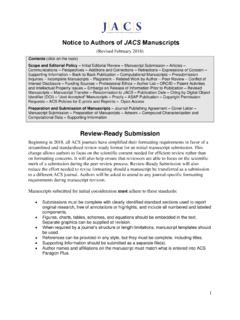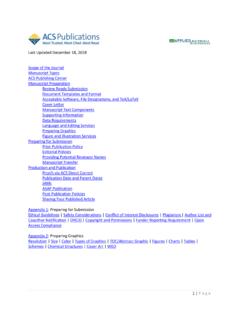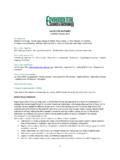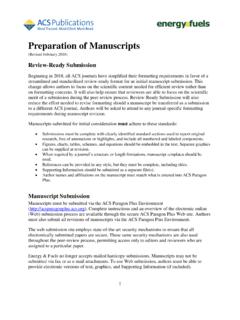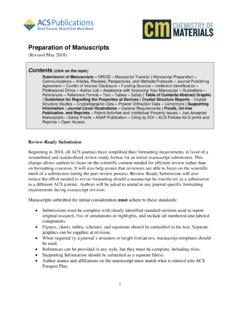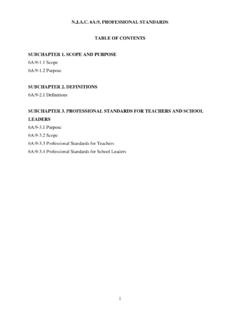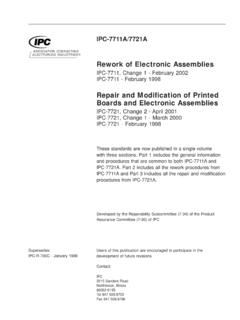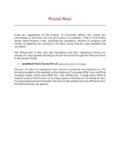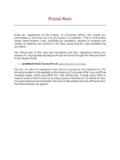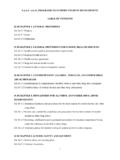Transcription of Preparation and Submission of Manuscripts
1 1 Preparation and Submission of Manuscripts (Revised Feb 2018) Contents (click on the topic) Preparation and Submission of Manuscripts Review-Ready Submission Title Page Abstract Introduction Results and Discussion Experimental Section Associated Content Author Information Acknowledgments References Nomenclature Abbreviations Graphics Table of Contents/Abstract Graphic Chemical Structures Tables Recommendations for Crystal Structure Papers Published Manuscript Conflict of Interest Disclosure -- Reviewer s Material | Supporting Information | Journal Publishing Agreement | Assistance with
2 Improving Your Manuscript | Author List | Professional Ethics | Funding Sources | ORCID | Institution Identification | Manuscript Transfer | Open Access | Manuscript Submission Web Submission General File Preparation Currently Acceptable Word Processing Packages | ACS Policies for E-prints and Reprints | Galley Proofs | Additions and Corrections | Retractions | Expressions of Concern Review-Ready Submission Beginning in 2018, all ACS journals have simplified their formatting requirements in favor of a streamlined and standardized review-ready format for an initial manuscript Submission .
3 This change allows authors to focus on the scientific content needed for efficient review rather than on formatting concerns. It will also help ensure that reviewers are able to focus on the scientific merit of a Submission during the peer review process. Review-Ready Submission will also reduce the effort needed to revise formatting should a manuscript be transferred as a Submission to a different ACS journal. Authors will be asked to attend to any journal-specific formatting requirements during manuscript revision. Manuscripts submitted for initial consideration must adhere to these standards: submissions must be complete with clearly identified standard sections used to report original research, free of annotations or highlights, and include all numbered and labeled components.
4 Figures, charts, tables, schemes, and equations should be embedded in the text. Separate graphics can be supplied at revision. When required by a journal s structure or length limitations, manuscript templates should be used. References can be provided in any style, but they must be complete, including article titles. Supporting Information should be submitted as a separate file(s). Author names and affiliations on the manuscript must match what is entered into ACS Paragon Plus 2 Title Page Manuscripts may be submitted as Full Articles, Notes, Rapid Communications, Reviews, Book Reviews, and Editorials (by invitation) (see Scope and Editorial Policy document).
5 The manuscript title should appear on a separate page and should be followed by the author names and the institution name and address. The title, author name(s), and affiliations should all appear on their own respective line of text. Place an asterisk after the name of the author to whom enquiries regarding the paper should be directed and include that author s telephone and fax numbers and e-mail address. Author affiliations must be footnoted using the following symbols in order (which should be used as superscripts): , , , , , , O. Subdivisions ( , departments) of an institution should be grouped on the same line or lines.
6 In article titles, the words new or novel (with the latter referring specifically to a compound based on an unprecedented carbon skeleton) should not be included, and the number of new substances obtained should not be specified. The title page and the rest of the manuscript should be typed in font size 12. Abstract The abstract, detailing, in a single paragraph, the problem, experimental approach, major findings, and conclusions, should appear on the second page. It should be double spaced and should not exceed 200 words for Full Articles and Reviews or 100 words for Notes and Rapid Communications.
7 Compounds mentioned in the abstract, and given as specific Arabic numerals that are bolded in the text, should also be accompanied in the abstract by the same bolded numerals. The abstract should be on a separate page and should be provided with the bolded and capitalized heading ABSTRACT . Introduction The manuscript should include an untitled introductory section stating the purpose of the investigation and relating the manuscript to similar research. Results and Discussion The Results and Discussion should be presented as a coherent whole section, in which the results are presented concisely.
8 The discussion should interpret the results and relate them to existing knowledge in the field in as clear and brief a fashion as possible. Tables and figures should be designed to maximize the presentation and comprehension of the experimental data. Authors submitting a manuscript as a Note should omit the heading Results and Discussion . For Full Articles of unusual length, subheadings may be included within the Results and Discussion section. The major heading Results and Discussion should be bolded and capitalized, with the text starting on the line following.
9 Subheadings are indented, followed by a period, and are a mix of uppercase and lowercase letters. The text follows on the same line as the subheading. Bolded structural code numbers should only be used for new compounds and for those known compounds for which new biological data or spectroscopic values are being reported, and should be presented in the main text in ascending numerical order. Authors providing Manuscripts focusing on the biological properties of two or fewer known natural products have the option of referring to the compound(s) concerned by name, rather than assigning each a bolded numerical code 3 number.
10 Other known compounds should be referred to in the text by name, wherever necessary. Sugar units in glycosides should not be inferred as D or L based solely on NMR data analysis, but should be determined by supporting experimental work such as measurement of their optical rotations following acid hydrolysis or by the Preparation of chiral derivatives and comparison with standards using a chromatographic analytical method. If the aglycone of a glycoside is also a new compound, then it should be isolated and its physical constants and spectroscopic parameters stated.
